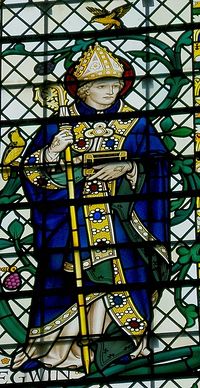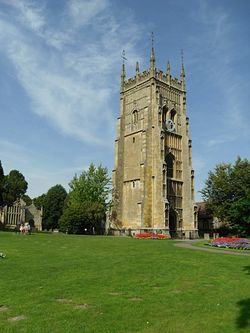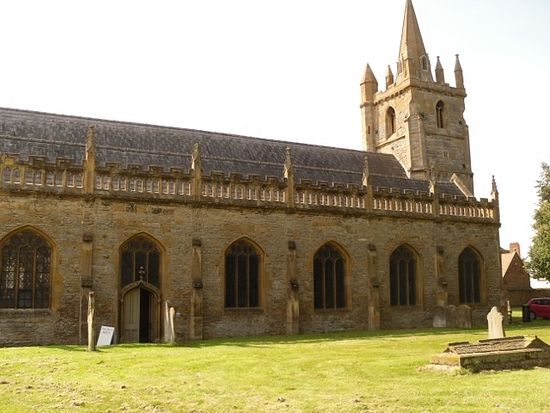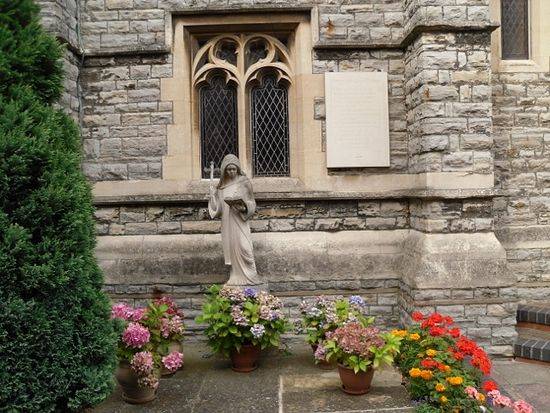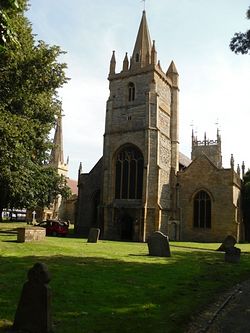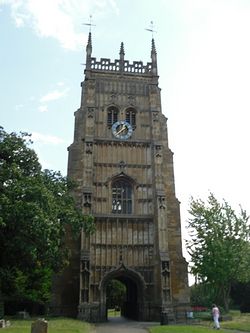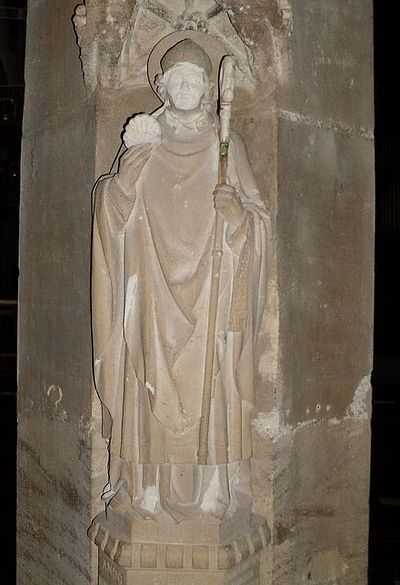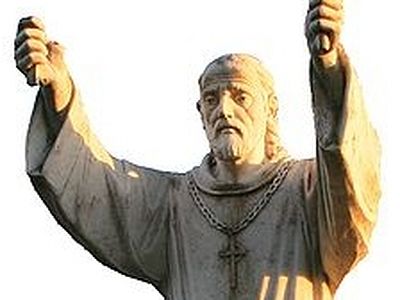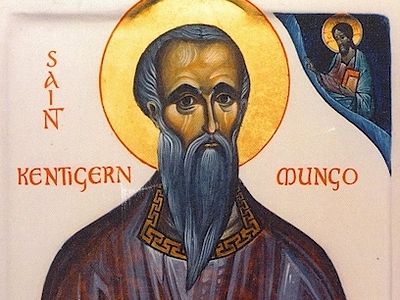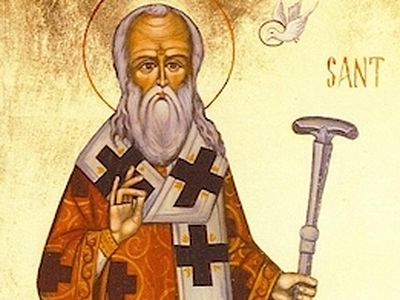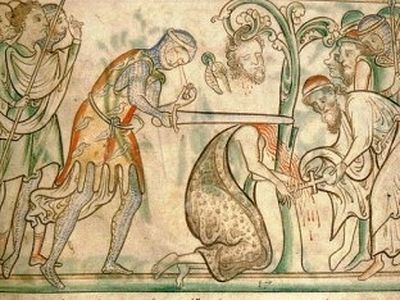The future saint was born in the 7th century and was probably related to the royal family of the Kingdom of Mercia. His parents were pious Christians and raised their son in the faith. Egwin devoted himself to the service to God from his childhood and with time was ordained priest. After several years of illustrious ministry as a priest, in 692 or 693 Egwin was against his will elected the third Bishop of Worcester in western central England. At that time Worcester was the main city of Hwicce, which was not an independent kingdom, but a province of Mercia. At that time Hwicce was still mainly pagan. The episcopacy of Egwin coincided with the long and successful reign of King Ethelred of Mercia who founded monasteries in his kingdom.
The hierarch fully devoted himself to the service to people. He preached the Word of God with zeal. The people at once came to love him for his prudence, fairness and honesty. Egwin was by nature affable and meek, but he also could be strict and unshakeable—in cases when the Truth of God was to be defended. According to one legend, once some people who had fallen away from Christian teaching slandered the future saint. The latter took this with great humility but at the same time, caring for his flock, he decided to prove his innocence. So he decided to make his way to Rome, having first put himself into irons and thrown the key into the River Avon.
Taking several helpers with him, the bishop boarded a ship in Dover and set off to Italy. Enduring all the difficulties of the journey with humility, he at last arrived at Rome. There he hastened to the shrines of Holy Apostles to pray. On the way he stopped at a bridge and asked his assistants to catch some fish in the Tiber for dinner. When he left the church, one of his companions made him glad with good news: they had caught a large fish and when they were preparing it they had found in its stomach the key of the irons that the saint had thrown into the Avon in England. The innocence of Egwin was confirmed by this miracle. Now acquitted, he returned to Worcester.
King Ethelred became more and more attached to the saintly bishop and soon entrusted the education of his sons to him. The holy bishop, to whom the people referred as their "father", confirmed his preaching with the example of his life and worked many miracles. With time, he more and more often began to retreat for quiet prayer. He was particularly attracted to a wild, wooded place on the bank of the River Avon, called Hethom (later known as Evesham). The saint asked King Ethelred to grant him this land and the latter gladly agreed to it. The holy hierarch felt that this place was special and chosen by God - this was soon to be confirmed: the Monastery of Evesham was to be founded there, which afterwards was considered among the largest and most important in England and even Western Europe. This happened in about the year 702 or 709.
Once a certain herdsman named Ioves was searching for a pig that had gone astray. He walked deep into the forest and saw the Mother of God with two angels on the site of present-day Evesham. The Holy Virgin was holding an open book and a cross in her hands, and wonderful singing could be heard around her. Amazed by this vision, the herdsman told Bishop Egwin about the miracle. The saint prayed very hard for several days and then decided to go to that place himself. The holy hierarch had exactly the same vision, which had already appeared to Ioves. The Mother of God ordered Bishop Egwin to found a monastery on the site and blessed him with a cross. This event is considered to be the first recorded miraculous appearance of the Mother of God in England. Egwin hastened with great joy to fulfil the order of the Most Pure Virgin and, with the support of King Ethelred, founded Evesham Monastery soon after that (the town's name "Evesham", according to a popular version, means the home of Iove, or Ioves’ home, after the herdsman). The town in the county of Worcestershire, where this monastery was founded, bears this name to this day.
Soon after the foundation of the monastery, the pious King Ethelred abdicated the throne in favour of his nephew Coenred and became a monk at the monastery of Bardney in Lincolnshire, where he lived until his repose. Coenred too was a devout Christian and did his best to support Egwin. In the year 709 Bishop Aldhelm of Sherborne, with whom Bishop Egwin had for many years been bound by spiritual friendship, reposed. On the same day in a miraculous dream it was revealed to Egwin that his close friend had died. He hurried to Doulting in Somerset, where Bishop Aldhelm had reposed. Then he accompanied the procession with the bishop's body on the journey from Daulting to Malmesbury (Wiltshire), and at his command crosses were erected at each stop in memory of the deceased. In the autumn of the same year in the town of Alcester in Warwickshire, not far from Evesham, a Church Council met. This specifically recognised all the privileges granted to the monastery of Evesham by the Pope and the kings. After the Council, Bishop Wilfrid of York went to Evesham together with Bishop Egwin and consecrated the church to the Mother of God, the holy Apostles Peter and Paul and All Saints (later on, Evesham Monastery was dedicated to the Mother of God and St. Egwin).
In 710 St. Egwin became the first Abbot of Evesham, which had been founded and was loved by him. At the same time, he most likely continued his service as Bishop of Worcester. Monastic life in Evesham soon began to flourish. Though Egwin was already venerated as a saint, his sainthood was particularly revealed during these final years of his life: miracles happened through his prayers, visions of the heavenly world appeared to him and holy men and angels came to him and communicated with him. The Bishop especially loved the Mother of God—her name was on his lips and prayer to her was in his heart all the time. The most Holy Virgin helped him more than once. At the same time, he did not stop looking after his brethren and his flock. The monks of Evesham dedicated most of their time to prayer, study of the Scriptures and other spiritual books, as well as different crafts.
Before his death the venerable abbot was stricken by a long and serious illness, which he endured with great patience, and his prayer did not weaken until the last minute of his life. Bishop Egwin reposed on 30 December 717. The day of his repose later became his feast-day. Since then St. Egwin has become the patron saint of Evesham and its monastery. Soon after Bishop Egwin's repose his incorrupt relics were discovered and laid in a richly decorated shrine. St. Egwin was much loved and venerated in Evesham by its monks, citizens and pilgrims until the Reformation; he was also venerated in many other large monasteries in England.
Over the centuries there have been constant miracles from St. Egwin’s relics and through his intercessions. Besides the relics of St. Egwin, Evesham possessed relics of three other saints, who were also highly venerated. These were the relics of St. Credan, Abbot of Evesham (+780); the holy martyr Wistan of Mercia (+ 850 whose relics were kept in Evesham from the 11th century); and St. Odulf, a missionary and founder of a monastery in Utrecht (+ 855, a portion of his relics was brought to England in the 11th century). Miracles occurred through the prayers of all these saints.
Unfortunately, the monastery at Evesham was dissolved and completely destroyed in the 1530s during the Reformation. Almost nothing survived of a once huge and very famous monastery, and the relics of all its saints disappeared. But, in spite of all this, the memory of St. Egwin lives in Evesham to this day; Orthodox and Roman Catholic pilgrims come here. This small, pretty town to this day preserves the specific and rare atmosphere of holiness, peace and tranquillity. This spirit can be felt the best on the site of the former monastery.
Today pilgrims here can visit two ancient churches of the 13th century (dedicated to St. Laurence and All Saints), which were built by the monastery for the citizens. Near them, there are the remains of the ruins of Evesham Abbey and the former Abbey bell-tower, which is a real gem. Built early in the 16th century, it is a tower with a clock and a gate and contains a set of eight fine bells. There are also the town museum, the Abbey Park and the Roman Catholic church of the Holy Virgin and St. Egwin. We hope and pray that one day an Orthodox church will appear here, on a site chosen by the Mother of God.
